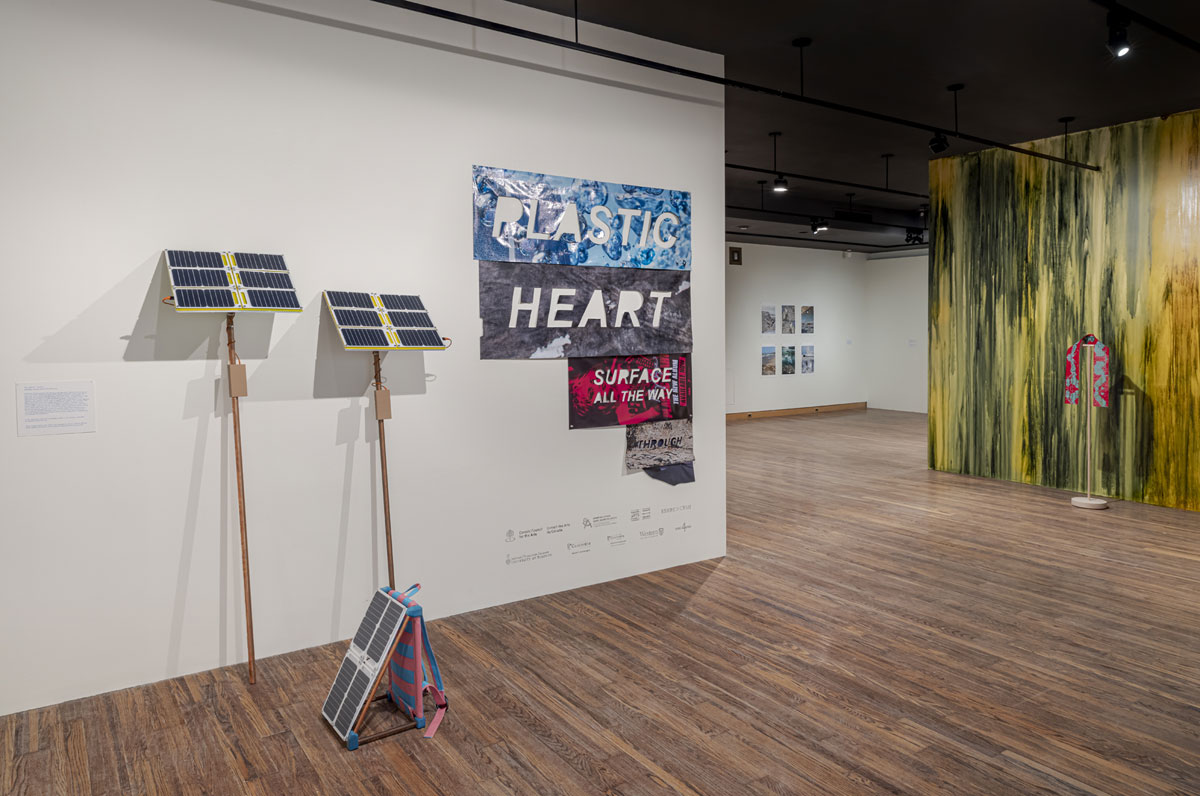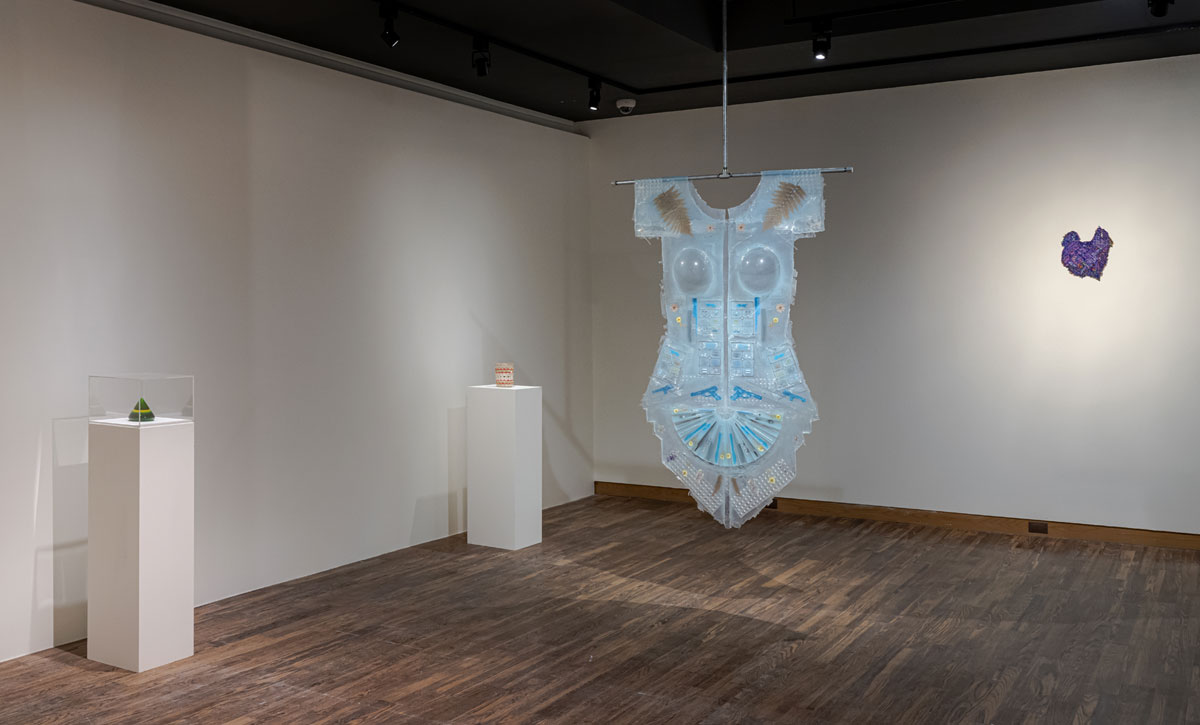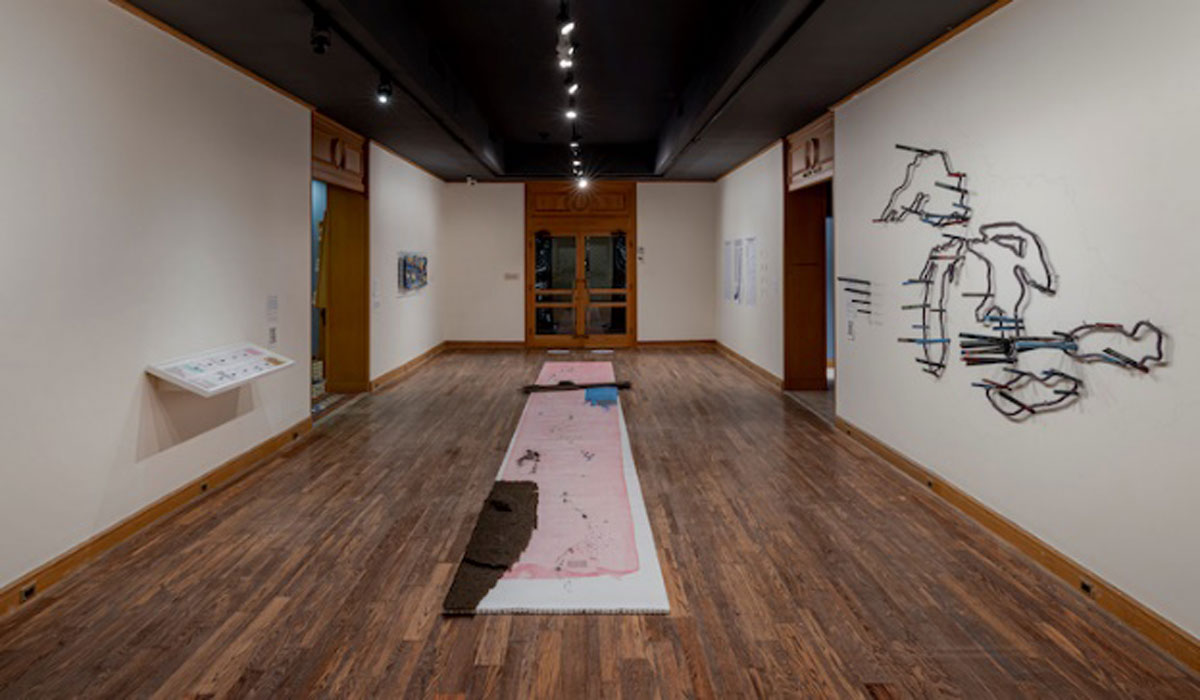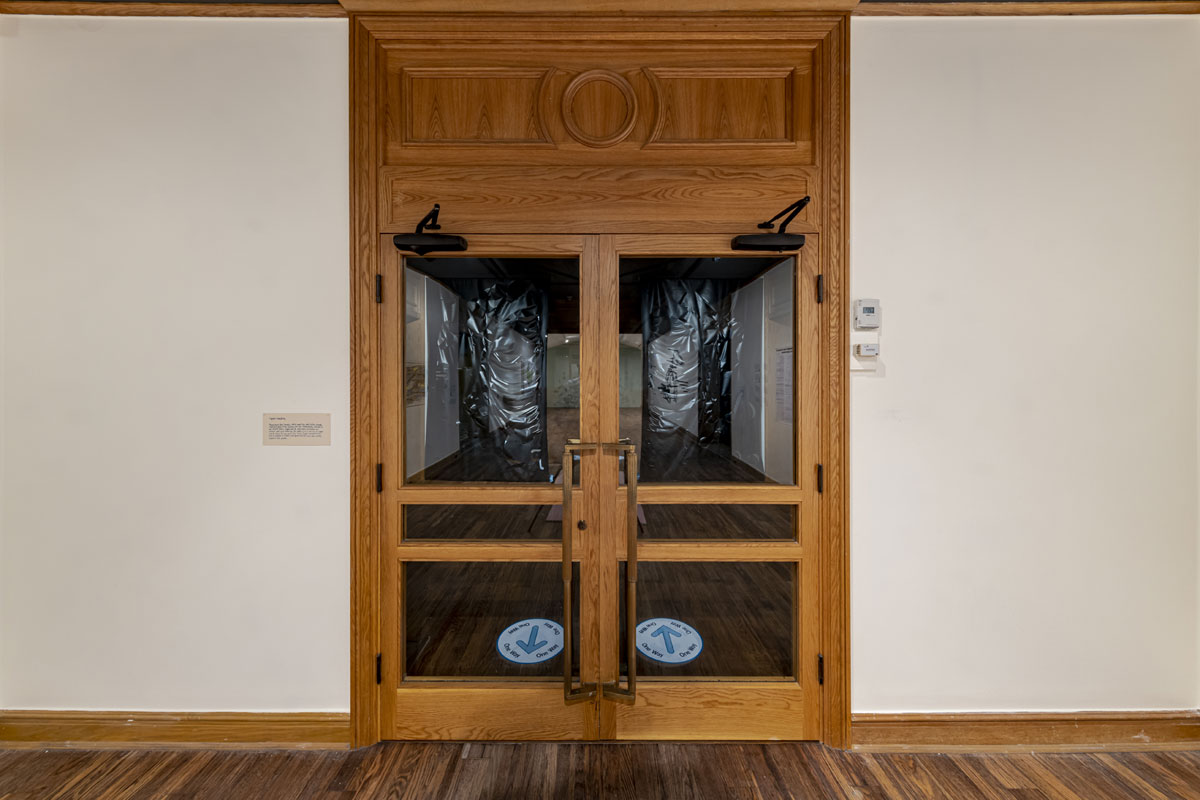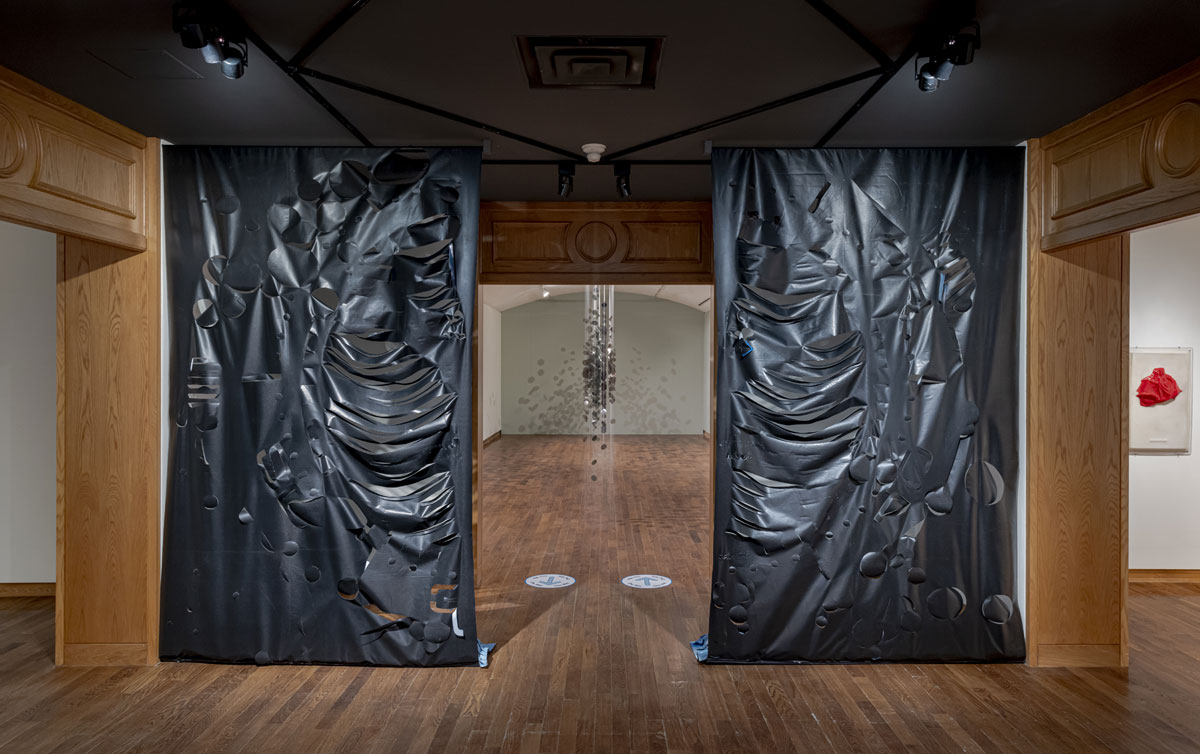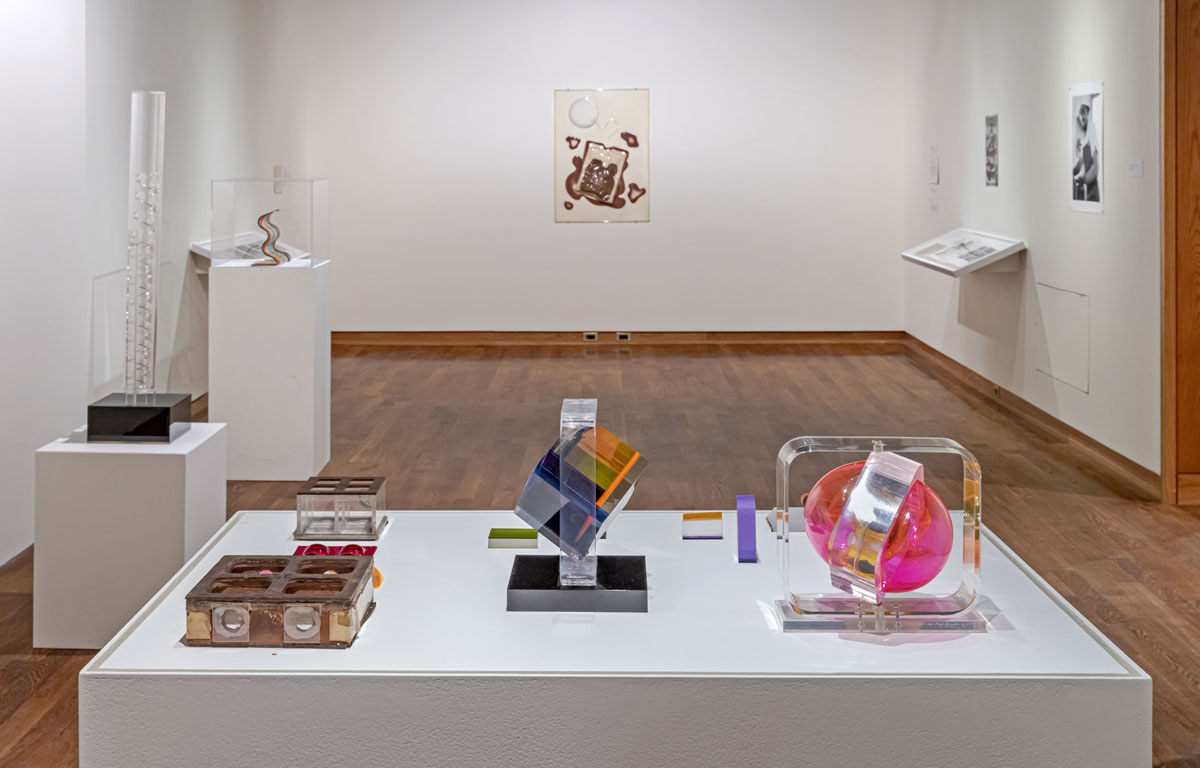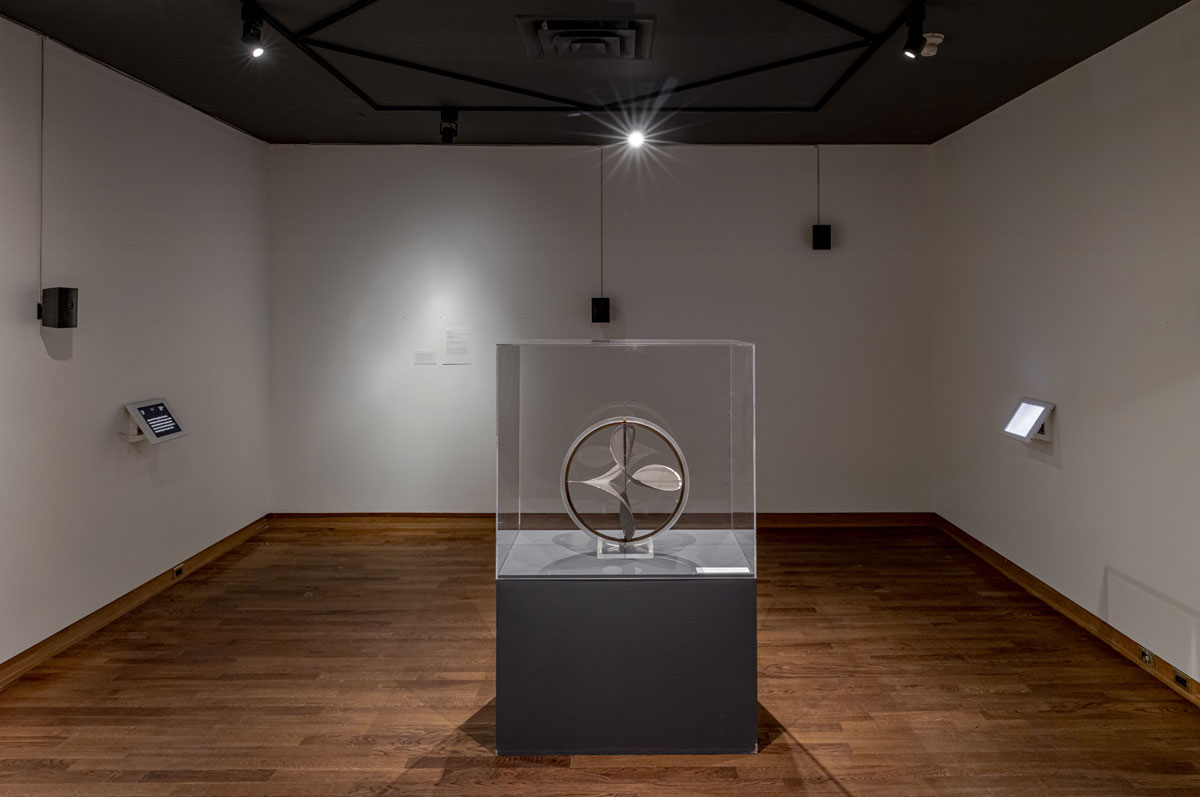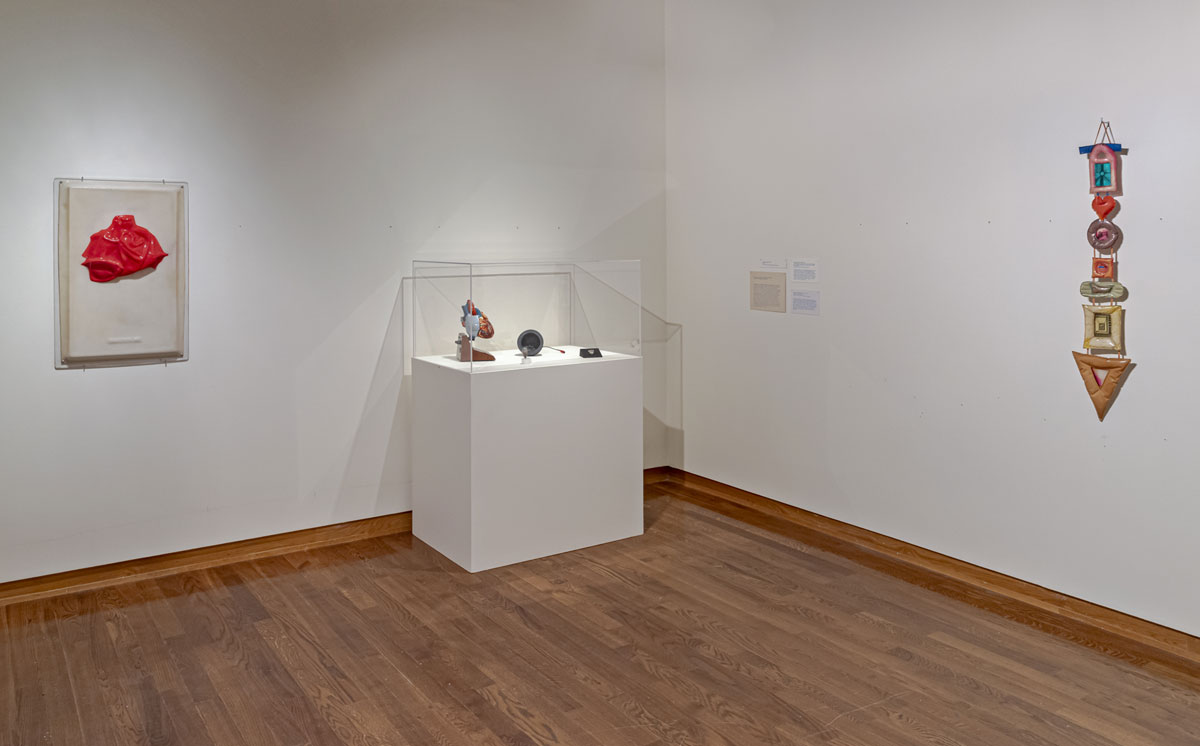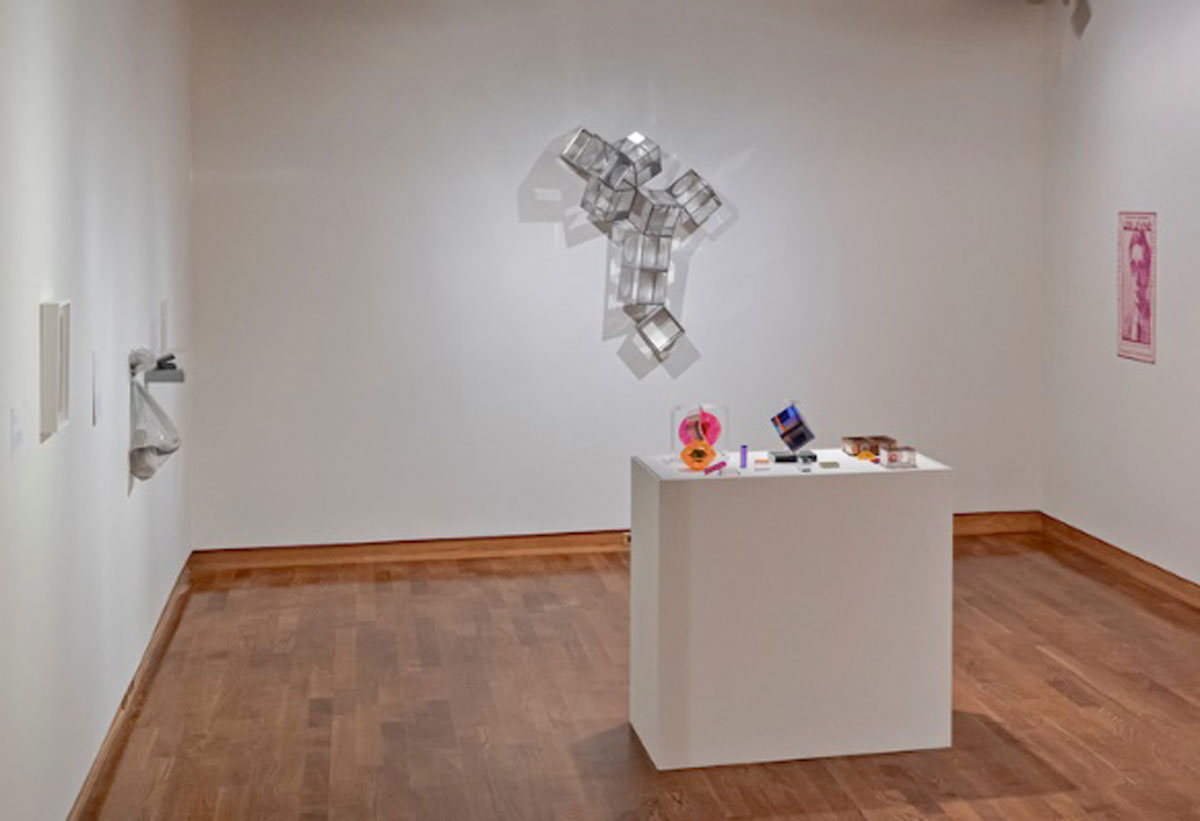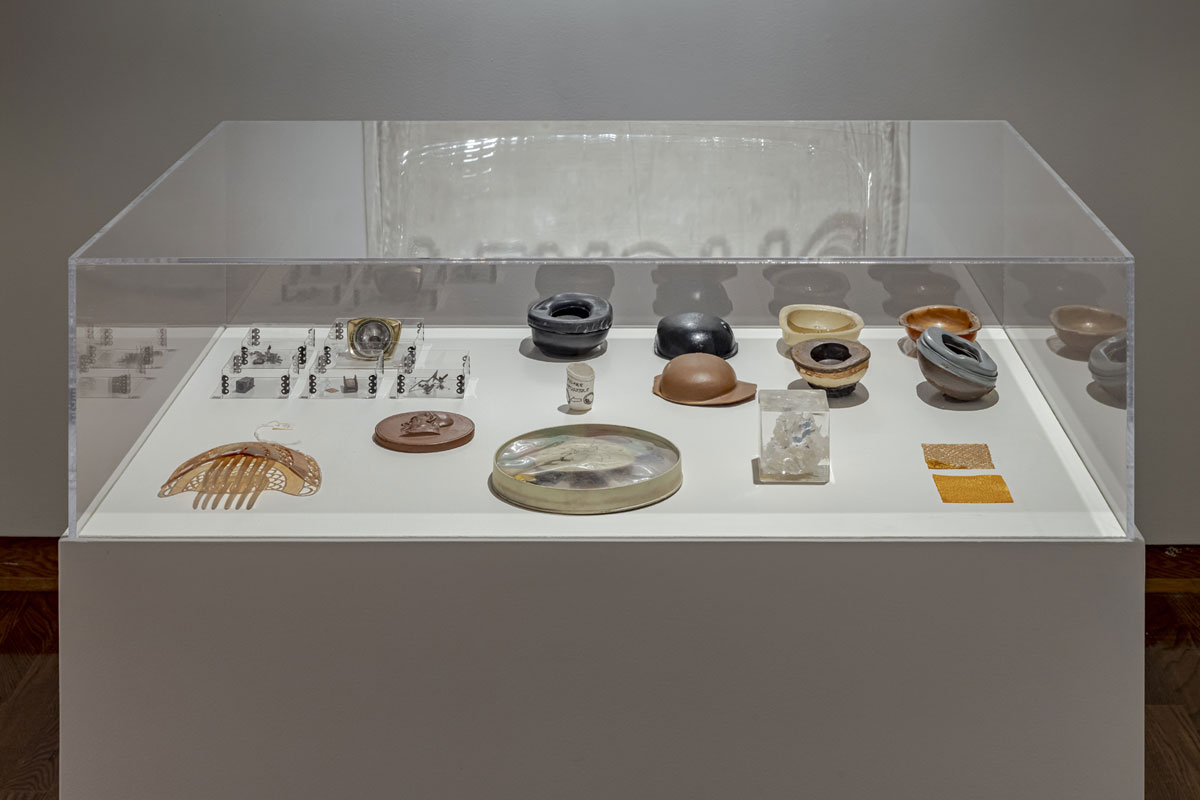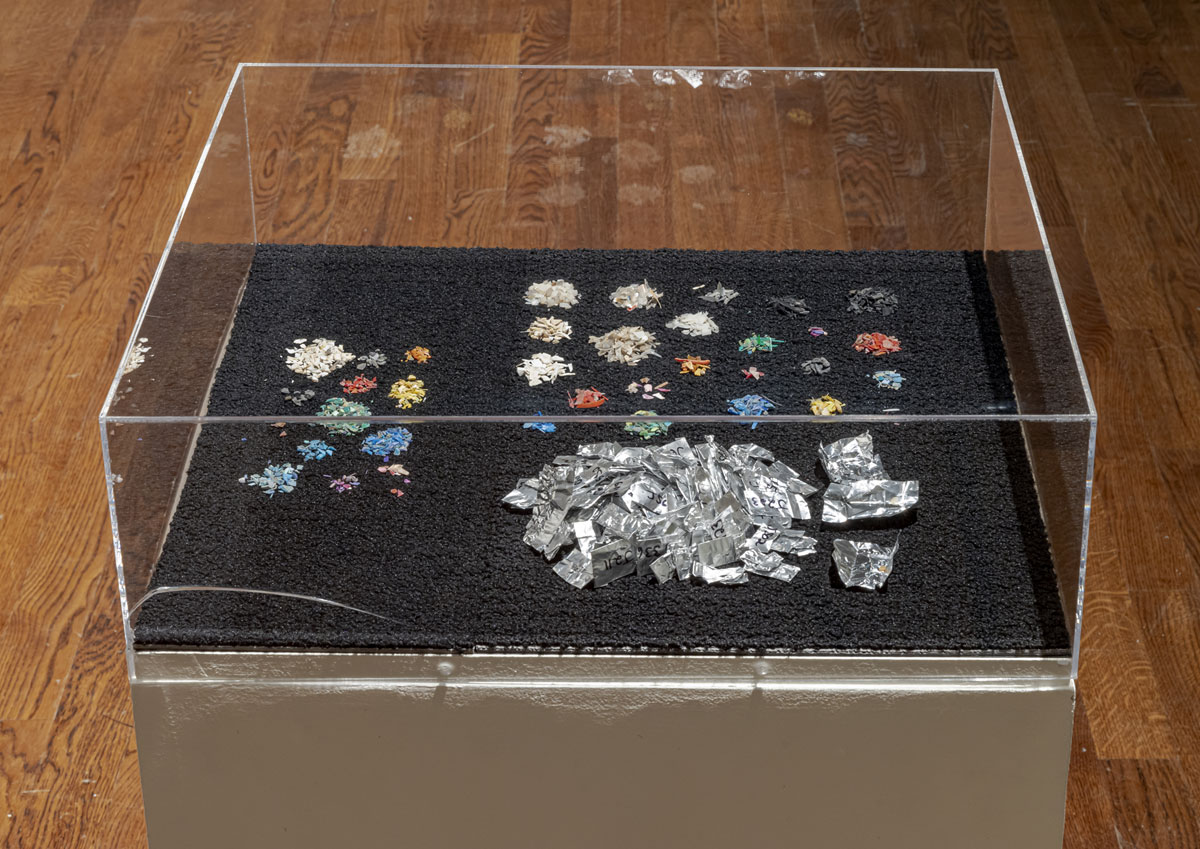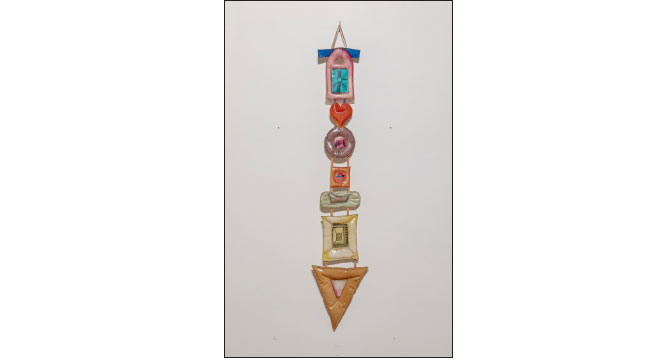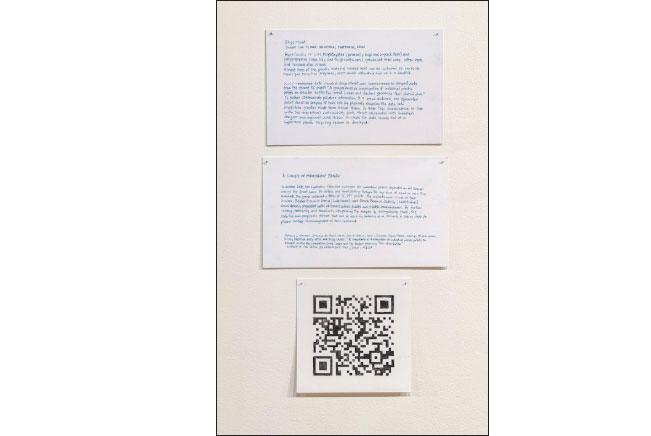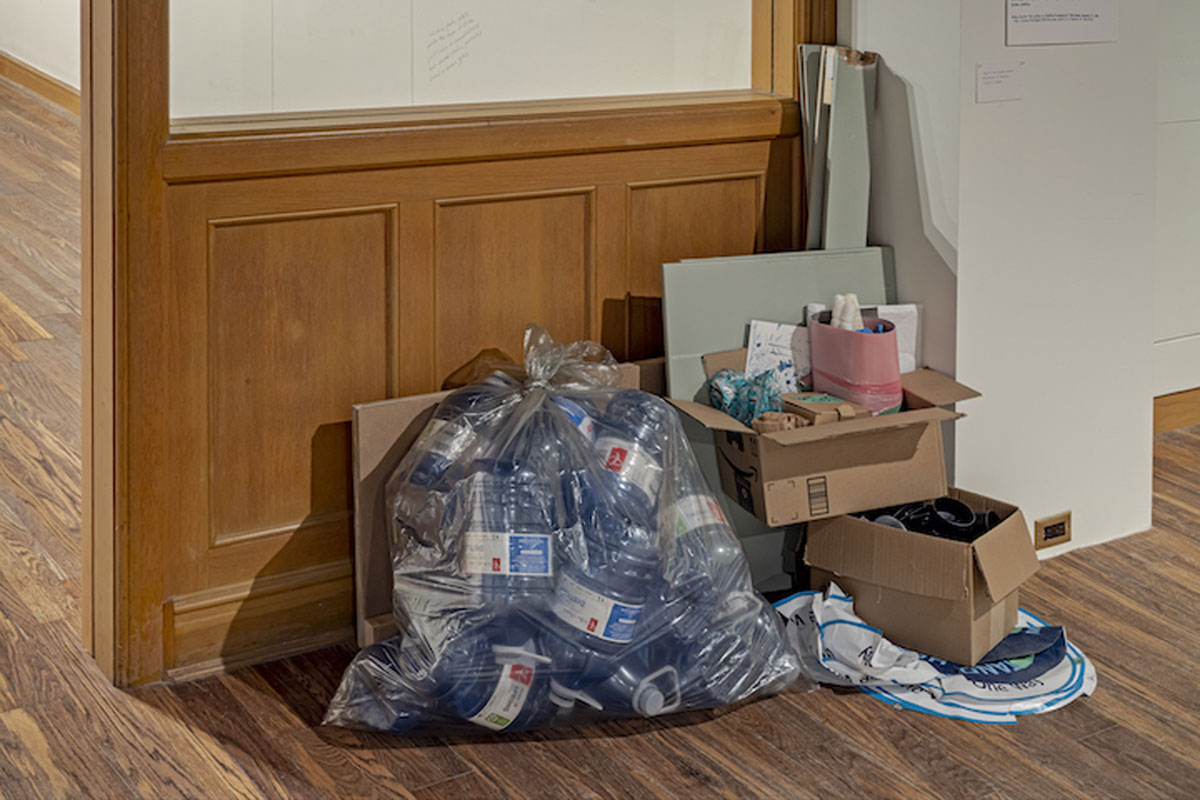1. Introduction
In September 2021, amid a pandemic lockdown, the exhibition Plastic Heart: Surface All the Way Through opened at the Art Museum at the University of Toronto. Conceived and curated by the Synthetic Collective, an art-science collaboration, the exhibition operated on a four-part premise aimed at comprehending the intricate relationship between the art world and plastics. Firstly, it sought to translate scientific research on plastics pollution, conducted by members of the collective, into visual materials. Secondly, it aimed to include artworks from the 1960s to the present that explored the aesthetic qualities of plastics. Thirdly, it examined how plastics degrade even within the controlled environments of museum storage. Finally, the exhibition itself functioned as an auto-critique, with deliberate decisions made at each stage to minimize its carbon footprint and avoid the use of plastics.
This contribution reflects on the insights gleaned from curating Plastic Heart. It advocates for layered curatorial methods that simultaneously address climate change and waste from multiple perspectives. Furthermore, it offers resources and suggestions for curators who are mindful of the carbon footprints and other ecological impacts of their exhibitions.
2. Plastics
Plastics play critical roles in human lives. Despite being invented just a century ago and gaining popularity as consumer products in the 1940s, plastics now exert influence over every facet of daily life. As noted by Jeffrey Meikle (1997: 2), the adaptability of plastics has yielded substantial positive outcomes in areas like food hygiene, transportation, and healthcare. However, the positive impacts of plastics are counteracted by what Synthetic Collective member Heather Davis (2022) refers to as the ‘unfathomable accumulation’ of plastic waste. Our lives are permeated by plastics; they are everywhere. There are thousands of different polymers that are grouped under the single moniker of plastics. Primarily by-products of the oil, gas, and coal industries, plastics are cheap to produce and easy to throw away (Meikle, 1997: 270–72). But they are not easy to dispose of, and their presence as ‘matter out of place’ (Douglas, 1966: 36) is becoming increasingly conspicuous. As Rebecca Altman expressed in a recent article in The Atlantic: ‘The demand for plastic has been as manufactured as plastics themselves. Society is awash in throwaway plastics not because of the logic of desire but because of the logic of history and of integrated industrial systems’ (Altman, 2022). Altman highlights the significant surge in plastic production, stating, ‘More plastics have been made over the past two decades than during the second half of the 20th century’ (Altman, 2022). Almost daily, new research emerges documenting the pervasive presence of discarded plastics. Plastic debris has been discovered at both the North and South Poles, in the Mariana Trench (the Earth’s deepest point, plunging some 10,000 meters into the Pacific Ocean), strewn across remote mountain peaks and plains, and even in outer space, where tens of thousands of space debris fragments—many of them plastic—circulate Earth in perpetual orbit (see Allen et al., 2019; Aves, 2022; and Kane and Clare, 2019). As Davis succinctly phrases it:
If rates of plastic production continue with contemporary waste management practices, it is predicted that by 2050 twelve billion tonnes of plastic will be in landfills and throughout the wider environment. It is hard to fathom such a large number, and we have very little understanding of what this may mean to ecosystems and to human health. (Davis, 2022: 8)
She concludes: ‘The world is now plastic’ (Davis, 2022: 3).
Plastics are so prevalent both in the world and within museums that they offer a crucial tool for grappling with how museums can address the climate emergency. Depicting climate change is notoriously challenging. As Timothy Morton (2013: 180) suggests: ‘The more data we have … the less we know … the more we realize we can never truly know’. Climate change and its associated waste are ‘wicked problems’, a term introduced by Horst Rittel and Melvin Webber (1973) to describe societal or cultural issues that are challenging to articulate and difficult to solve in a straightforward or final manner.
While numerous museums and galleries have highlighted the works of eco-artists and presented educational exhibits pertaining to climate change, climate anxiety, paralysis, and guilt are nevertheless all possible responses. The Synthetic Collective embarked on curating Plastic Heart with an awareness of these limitations. However, we held the hope that the familiarity of plastics and their significance in the art world could provide multiple avenues for contemplating climate change and waste, while concurrently fostering paths to action for both visitors and institutions. Luminous artworks of extraordinary beauty were juxtaposed with scientific research and degrading plastic artifacts, all of which were situated within our own endeavors to minimize further environmental harm during the exhibition’s creation.
Our aim was to create a kind of friction within the gallery space, combining aesthetic excitement, impactful research, a willingness to learn, and an openness to take action. As we put it in the opening statement of a Manifesto created as an integral part of the exhibition: ‘If you are going to make it, make it count’.1
3. Plastic Heart: Surface All the Way Through
Immediately upon entering Plastic Heart, visitors were made aware that they were encountering something unusual. Custom-designed portable solar signboards, umbrellas, and backpacks, used to supply power to the exhibition’s electronics, were scattered around the entrance. These items served as distinct and distinctive indicators of the exhibition’s use of alternative energy sources. The exhibition title was fashioned by cutting from repurposed vinyl banners, which were suspended above the donor wall featuring the names and logos of sponsors rendered on the surface using colored pencils.2
The University of Toronto Art Centre3 is a large single-story space divided into numerous smaller rooms. It is not a conventional white cube gallery; the dimensions of the rooms are unconventional and clustered around the Malcove collection of Medieval art and Byzantine icons. The clean walls and hardwood floors typical of gallery spaces are punctuated by the mid-nineteenth-century architectural features of the building. The wooden floors transition into vibrant ceramic tiles, while the rooms are partitioned by weighty oak doors equipped with copper hardware. The overall aesthetic blends elements of the white cube concept with a touch of ecclesiastical ambiance. The space is both challenging and comforting, compounded by the circumstance that only half of the museum adheres to museum-standard climate controls.
Hence, the spatial arrangement, to some extent, dictated the organization of Plastic Heart. Near the entrance, works by contemporary artists such as Woomin Kim, Laetitia Bernaus, Meghan Price, Lan Tuazon, Amy Brener, Catherine Telford-Keough, Fred Eversley, J Blackwell, and Meagan Musseau were juxtaposed with a commissioned piece by Nico Williams (ᐅᑌᒥᐣ Anishinaabe from Aamjiwnaang First Nation). His work naabibii’ige featured an image of the Great Lakes deconstructed and reassembled into the form of a beaded sash or belt. On the opposing wall, Synthetic Collective member Kelly Wood’s digital collage series comprising recomposed and reconfigured crowd-sourced imagery of plastics pollution in the Great Lakes was displayed. Because the Synthetic Collective opted against repainting any walls, Plastic Heart inherited a work from the prior exhibition. Christopher Mendoza’s wall-based artwork, visible in Figure 1, was created using ink extracted from invasive buckthorn berries—a plant species introduced to Southwestern Ontario by European settlers. The show’s introductory space brought together contemporary artists addressing themes of plastics, polluted waters, Indigenous lifeways, and the Great Lakes.
Entrance to Plastic Heart: Surface All the Way Through; portable solar panel umbrellas and backpack designed and assembled for Synthetic Collective by Nicolas Lapointe and Shelley Ouellet. Also visible is Kelly Wood, Great Lakes: Accumulations, 2020, digital photographs/water-based ink on cotton rag paper; Nico Williams ᐅᑌᒥᐣ, naabibii’ige, 2021, glass beads, thread; Christopher Mendoza, yet you dream in the green of your time, 2019–2021, ink made of buckthorn berries from the lower Don River Valley, alum, and gum arabic, museum wall. Photo credit: reproduced with the permission of the copyright holder, Toni Hafkenscheid, 2021.
Moving into the central gallery (Figure 3), the focus shifted to the Synthetic Collective’s exploration of plastics pollution in the Great Lakes region. The Synthetic Collective has been active since 2013, and in 2018 undertook an extensive sampling study, surveying for industrial plastic pellets or ‘nurdles’, along the shorelines of all five Great Lakes. The Great Lakes region spans across the province of Ontario in Canada and eight states in the US, including Illinois, Indiana, Michigan, Minnesota, New York, Ohio, Pennsylvania, and Wisconsin. Holding over 20 percent of the world’s surface freshwater reserves, the Great Lakes are an inland ocean system nestled within a basin shaped 20,000 years ago as receding glaciers relinquished their hold on the land (Hennings and Lynch, 2017). Encompassing near pristine ecosystems and heavily polluted manufacturing centres, the Great Lakes region is hugely important economically, historically, and as a series of interlocked ecosystems. While the negative impact of pollutants on the Great Lakes has been acknowledged for some time, it is only recently that plastics pollution in the area has been given serious consideration (Corcoran et al., 2015). Indeed, the presence of such pollution is alarming. Recent studies have revealed that the accumulation of plastic debris in the Great Lakes’ surface waters, benthic sediment, fish, and seabirds rivals that found in oceanic garbage patches, with concentrations reaching as high as 6.7 million particles per square kilometer (Rochman et al., 2019).
Comprehending plastics pollution in the region is vital for both clean-up efforts and, more significantly, for halting the inflow of new plastics pollution into the Lakes. Nurdles, small plastic spheres typically measuring approximately 5mm, serve as the foundation for nearly all plastics manufacturing (Ballent et al. 2016). Fossil fuels are refined into the polymers composing these pellets, which are subsequently melted into recognizable consumer objects. These industrial pellets are produced in large quantities within the Great Lakes region, often leading to their release into the waters due to spillage (Corcoran et al., 2020; Rochman et al., 2019). Our study focused on collecting, characterizing, and mapping the quantities of pellets that had reached the beaches, creating a ‘snapshot’ of their dispersal. Artists, scientists, and writers within the Synthetic Collective underwent training on sampling techniques, and in October 2018, we sampled for industrial pellets on 66 beaches surrounding the Great Lakes. The process of counting and characterization spanned the subsequent year, and in 2019–2020, we published a paper documenting the 12,595 pellets collected (Corcoran et al., 2020). The study provided evidence that the pellets primarily entered the water in areas densely populated with polymerization plants and plastic manufacturers. While our work contributed to the understanding of the quantity and dispersion of industrial pellets, it left questions unanswered: we had accumulated significant evidence, but were addressing solely a scientific community that was already well acquainted with these forms of pollution, if not their specific attributes. The challenge was twofold: how could we communicate our results beyond a single community, and how could we transform evidence into action? These questions led to the curation of Plastic Heart.
Within the central gallery of Plastic Heart (Figure 2), a collection of artworks that reflected upon and extended the study rooted the exhibition in the region. Toronto, situated on Lake Ontario, is close to the beach where we found the second-highest pellet quantities; the most substantial amount was discovered on Lake Huron’s shores near Sarnia, Ontario. On that beach, an astounding 7,268 pellets were retrieved from the upper 5cm of sand within a 1-meter by 10-meter quadrat. This beach’s sand was infused with white nurdles that remained mostly imperceptible until the sampling process rendered them visible—what appeared as sand suddenly transformed, revealing itself as thousands of plastic particles (Davis and Robertson, 2021: 43). Tegan Moore’s installation, Permeations of a Dataset, positioned on the floor, used nurdles collected from this beach, arranged in an echo of the form of a sampling quadrat. Pink, blue, and black plastic packaging further delineated the shape, and the materials displayed a range of degradation due to time and exposure, in some cases disintegrating and fragmenting further during the course of the exhibition. In the background, a subdued soundtrack could be heard marking the passage of time—the sound of the 12,595 pellets being counted and characterized.
Left to Right: Fred Eversley, Untitled, 1968, polyester resin; Meagan Musseau, E’e for that Aunty Magic, of the Intergalactic L’nu Basket series, 2019, black ash wood, sweetgrass, and plastic; Amy Brener, Flexi-Shield (Empress), 2018, platinum silicone, pigment, larkspur and chrysanthemum, flowers, fern leaves, miscellaneous objects; J Blackwell; Plastic Basket (B204), 2013, plastic bags, yarn. Photo credit: reproduced with the permission of the copyright holder, Toni Hafkenscheid, 2021.
Left to Right front: Christina Battle, THE COMMUNITY IS NOT A HAPHAZARD COLLECTION OF INDIVIDUALS, 2021, digital print on organic cotton, animated GIF, participatory project with seed packs (grass and wildflower seed, mycorrhizal fungi), instruction set, postcards, website; Tegan Moore, Permeations of a Dataset, 2020-2021, factory reject ‘mystery foam’ sheet with anti-static agent, hail-damaged polycarbonate roofing, photodegraded corrugated plastic, plastic pellets, plastic fragments, biodegradable starch packing peanuts, mulberry paper, salvaged phone and sound track (15 min looped); Skye Morét, Thank You to our Industrial Partners, 2020, hyperlocally recycled polyethylene, galvanized steel wire, cotton rope, and reusable steel screws. Left to Right back: Meghan Price, New Balance 6, 2020, used athletic shoes, painted steel grid; Heather Davis and Kirsty Robertson, Chemicals of Mutual Concern, 2020-ongoing, paper, ink derived from pollutants. Photo credit: reproduced with the permission of the copyright holder, Toni Hafkenscheid, 2021.
On the wall, Skye Morét’s data visualization rendered the distribution of plastic pellets in the Great Lakes easy to ‘see.’ The number of pellets collected from each beach in the study was represented through a shard made from plastics that would not be collected by municipal recycling programs. Morét transformed and ‘recycled’ these materials herself to create the stalagtite-like forms. Her visualization of the study clearly showed the clustering of pollution in regions heavily dominated by manufacturing. Heather Davis and Kirsty Robertson’s posters documented the huge number of plastics producers in the Great Lakes region, the chemical externalities of commonplace plastics manufacturing, and the many agreements and treaties governing pollutants and land ownership in the area. The posters underscored the extent of plastics production and showed how industrialization and agriculture had restricted Indigenous access to the waters. Christina Battle’s piece, The Community is Not a Haphazard Collective of Individuals, used a seed exchange to explore how plants could contribute to phytoremediating land impacted by the petrochemical industry. The works in this gallery centered the scientific processes of collecting, counting, characterization, and labeling, serving as research evidence documenting the extraordinary proliferations of plastics production and pollution while suggesting pathways toward different futures.
Leaving the central gallery, visitors passed through a pair of wooden doors equipped with copper handles (Figure 4). This particular set of doors delineates a transition within the gallery, shifting from the ambient environment to the climate-controlled area of the University of Toronto Art Centre. Despite being imperceptible, air is an important commodity in museums, regulated meticulously within specific parameters governing temperature and humidity. As pointed out by Fernando Domínguez Rubio:
Naturally occurring air is not very good for most artworks, since it is filled with abrasive and acidic particles (e.g., hair, skin cells, soot, fibers, pollen, metals, salts, or plaster) that can react with moisture to worsen chemical and mechanical deterioration. Art objects typically require an extreme form of clean air, in fact, much cleaner than the air we humans require to survive. Unfortunately, two centuries of industrial capitalism have made this type of ‘aesthetic air’ exceedingly rare. (Domínguez Rubio, 2020: 159)
The air in museums must be produced, and that production is expensive both in terms of monetary and environmental costs. For museums in polluted cities this is a particular quandary. Rubio notes that the conservation area of MoMA in New York City, for example, takes in only 20 per cent of urban air, ‘creating’ the rest of its interior environment from air that is recirculated and cleaned (Dominguez Rubio, 2020: 165).
The production of ‘aesthetic air’ is relatively new. Prior to the invention of HVAC systems in the 1930s, the care of museum collections depended primarily on simply trying to keep artworks and artefacts clean, removing evidence of, for example, smoke damage from collections in urban settings (Brommelle, 1956: 177). It was in 1978, with the publication of The Museum Environment by Garry Thomson, where the now nearly ubiquitous equation of a temperature of 70F or 20C plus minus 2 degrees and a relative humidity of 50 to 55 per cent was introduced. Though Thomson never intended his recommendations to be strictly adhered to in all circumstances, the book unexpectedly set museum standards and in doing so created an energy-intensive and narrow window for controlling interior environments, now reflected in International Council of Museums (ICOM) conditions specified for loans (Kirby Atkinson, 2014: 205).4 In short, unless temperatures and humidity levels fall within the established criteria, loans are often impossible.
This was certainly the case for Plastic Heart where many of our loans were only allowed to be shown behind the wooden doors in the climate-controlled section of the gallery. We wanted to draw particular attention to the two climates of the University of Toronto Art Centre. In the central gallery, visitors had learned about the effects that plastics manufacture has on air quality. Through Davis and Robertson’s posters they had seen the huge numbers of chemical compounds thrown into the air through plastics manufacturing. And through Moore’s work they had seen the effects of air and weather on the degrading plastics packing making up her quadrat floor sculpture. We wanted to draw attention to the way that maintaining the climate in the gallery implicitly erased the outside world, and also to the impossibility of maintaining a perfect seal.
Despite the double doors and carefully maintained HVAC systems, the outdoors seeped in. Ventilation can only control so much, and while HVAC systems prevented large fluctuations in temperature and humidity, during the period in question even air was suspect. Plastic Heart opened at the height of a pandemic in which the virus was spread through the air. The potential for the world outside to impact the museum remained evident through COVID-19 labelling dispersed through the exhibition (and visible on the floor in Figure 5). Interestingly, the Art Museum at the University of Toronto maintains the hardware of an earlier era – copper hand bars and hinges that appear to fit seamlessly with the nineteenth century architecture of the building. Our research, however, showed that copper and brass fixtures were remarkably common at the turn of the twentieth century not only because of their aesthetic appeal, but also because they have natural anti-microbial properties (Morrison, 2020; Walusinski, 2018). While copper has largely been replaced with plastics and stainless steel in hospital settings, it remains in many urban infrastructures, evidence of past attempts to control disease.
Front Left to Right: Kelly Jazvac, Semon’s Seaman, 2020-2021, salvaged billboard tarp, thread, sand, plastic pellets, aluminum; IAIN BAXTER&, Still Life, 1965, paint on vacuum formed clear plastic. Back: Hannah Claus’s chant pour l’eau/water song, 2014, digital print on acetate, thread, PVA glue, Plexiglas. Photo credit: reproduced with the permission of the copyright holder, Toni Hafkenscheid, 2021.
In the liminal space between the galleries, Kelly Jazvac’s curtains made from salvaged vinyl billboards cast shadows into the long gallery framing Hannah Claus’s chant pour l’eau/water song. Both Jazvac’s and Claus’s works moved gently in the space, drawing attention to the carefully controlled air. Additionally, both works referenced water. Jazvac’s curtains were made from an old advertising banner that featured a dramatic underwater escape scene printed on the vinyl, and Claus’s hanging sculpture is based on a digital reading of a Mi’kmaq water song, sung to celebrate and thank the water. Throughout the exhibition, discussions of plastics pollution kept returning to air and water, themselves the unwitting containers of pollutants.
Four small rooms opened off the central gallery at the back of the museum. In each, a mixture of historical works, plastic samples and specimens, and documentation drew out the two final investigations of the exhibition: first, an examination of historical plastics and their degradation even in controlled museum environments, and second, a closer look at the way artists from the 1920s to 1960s had experimented with plastics in their work.
To the left of the main doors, Naum Gabo’s Monument to the Astronauts, 1966, was spotlit seemingly alone in a dark room—an auratic object with a singular presentation that contrasted somewhat with other exhibits in the galleries (Figure 7). Gabo (1890–1977) is well-known as an early experimenter with plastics in his art. He strongly believed in scientific advances and felt that early plastics, such as cellulose acetate, would allow him to expand his interest in exploring three-dimensional space, primarily by constructing objects that held the tangible and intangible in opposition. Like Monument to the Astronauts his works often featured elegant twisting shapes held together through tension and counterweight.
Gabo chose to work with plastics because he believed they would not degrade like bronze or wood did (Rankin, 1988: 289). Unfortunately, this was not the case, and many of Gabo’s early works have been lost to time as the volatile early plastics he used have badly disintegrated. Gabo blamed museums for this destruction, believing that his work had been stored incorrectly and that the degradation was due to outside influence rather than inherent vice (Lodder, 2007). However, he did switch to Perspex (Poly[methyl methacrylate], also known as Lucite or Plexiglas) later in his career (Rankin, 1988: 289). Composed with far fewer volatile plasticizers than cellulose acetate, the Perspex works that Gabo created, including the Monument to the Astronauts, have fared much better in museum conditions, though they are still notably fragile.
Plastic Heart also included a photograph documenting the near complete disintegration of Gabo’s early work Construction in Space: Two Cones (1927),5 now a crumbling, dark brown pile of degraded plastic fragments that has little in common with the original work. In 2014, Danish artist Marianne Vierø was invited to the Philadelphia Art Museum to create a replica of the damaged sculpture in its broken state. She did so using 3D printing and new materials, creating a new work replicating not the original but its disintegrated progeny. Vierø’s replica will also degrade but more slowly and with better known outcomes, adding a clear temporal dimension to Gabo’s investigations of space. For Plastic Heart, Vierø was commissioned to reflect on the work that she had done in Philadelphia. She did so by creating a soundwork to accompany Monument to the Astronauts, reading the angry letters between Gabo and the Philadelphia Art Museum regarding the degraded state of his work and creating a resonant soundscape designed to capture the potential for disintegration and the emotional response it evokes.
The high-pitched sound of Vierø’s piece bled through the gallery space, in front of Jazvac’s curtains and into the room across the hall, which the curatorial team kept calling the ‘heart room’, in part because of the inclusion of a work by artist Joyce Wieland that incorporated a heart made of plastic, and in part because of the inclusion of several plastic heart specimens and teaching aids.
Wieland and IAIN BAXTER&, whose vacuum-formed work hung in the gallery near Wieland’s, were among the many artists exploring plastics as flexible new materials in the 1960s. The ‘heart room’ also featured a photo of Eva Hesse posing behind a sheet of acetate. In the adjacent gallery, a series of Arundel de Roy Gruber’s 1968 sculptures and the molds used to create them glowed in the center of a room that also displayed works by Claes Oldenburg, Françoise Sullivan, Les Levine, and Kiki Kogelnik, juxtaposed with documentation of past plastics exhibitions and artists at work, often in plastics manufacturing facilities. Many of these works maintain a luminosity and vibrancy that showcased why artists in the 1960s were so drawn to these new materials (Figures 6 and 8).
Front: Aaronel deRoy Gruber, Mini Cyclop-lexis, 1969, vacuum-formed Plexiglas and acrylic of various thickness laminated on an acrylic core; Component for a sculpture, 1969; tinted Plexiglas, acrylic; Molds and components for 2 ½’ bubbles and 1 ¼’ bubbles; Multiplex 4, 1971, solid acrylic (Lucite). Back Left to Right: Françoise Sullivan, Sans Titre, 1968, Plexiglas; Sans Titre, 1968, Plexiglas; Claes Oldenburg, Tea Bag, 1965, colour screen print, felt, plexiglass, rayon cord, and laminated vacuum formed vinyl; documentation of exhibitions and artists at work. Photo credit: reproduced with the permission of the copyright holder, Toni Hafkenscheid, 2021.
Naum Gabo, Monument to the Astronauts, 1966, brass, plastic, and stainless-steel gauze; Marianne Vierø, A Matter of Form, 2021, 5-channel audio composition with 2-channel video, partly nonsynchronous. Photo credit: reproduced with the permission of the copyright holder, Toni Hafkenscheid, 2021.
Left to Right: IAIN BAXTER&, Still Life, 1965, paint on vacuum formed clear plastic; heart display case (full attribution given in Figure 9); Joyce Wieland, Home Art Totem, 1966, mixed media. Photo credit: reproduced with the permission of the copyright holder, Toni Hafkenscheid, 2021.
However, even then, artists were aware of the consequences of using plastics. In an exhibition poster for Plastics, a show at the Art Gallery of Ontario in 1967, which was included in the final gallery of Plastic Heart, Joyce Wieland is quoted as saying, ‘The same corporate structure which leases napalm to responsible groups at reasonable rates gifts you with inexpensive fun things made of plastics. Plastic dishes are known carcinogens’. In a review of the 1967 exhibition, Kay Kritzwiser referred to plastic coffee cups as ‘a horrid reminder of the age we live in’, and artist Michael Hayden noted that concerns about the odor of plastics meant he would ‘use a gas mask whenever I spray my plastics’ (Robertson, 2021).
Left to Right: Heart Demonstration Model, date unknown, plastic; Plastinated hearts of a raccoon and a mouse, 2017; EKG Electrode for Whale, 1989, synthetic rubber, PVC pipe, plastic connector socket ‘Plumber’s Friend’ modified with socket and lead to hold electrode to whale for reading EKG; Lippes Loop Intrauterine Device (IUD) c. 1957, polyethylene, barium sulfate. Photo credit: reproduced with the permission of the copyright holder, Toni Hafkenscheid, 2021.
Thus, artists were aware, and plastics companies were aware. But the full extent of the problems posed by plastics remained mostly in the future, and the aesthetic possibilities of using plastics were incredibly tempting. Nevertheless, the quotes from Wieland, Kritzwiser, and Hayden sit uncomfortably with the documentation of Eva Hesse wrapped in plastic. Although no causal connection to her work with industrial latex has been established, Hesse died in 1970 at the age of 34 from a brain tumor, leaving behind a legacy of cutting-edge work that, like that of so many other artists, is almost unrecognizable from its early form, having darkened, yellowed, and cracked with age (Barger, 2007). Despite their luminosity, degradation was apparent in many of the works from the 1960s included in Plastic Heart, with noticeable issues such as cracking, embrittlement, fading, microcrazing, and discoloration.
This was especially true of some of the artefacts included in Plastic Heart, most of which were chosen specifically to demonstrate plastics degradation. In the heart room, a DIY heart monitor used on whales and made from a toilet plunger showed evidence of ‘blooming’, a white powder on the surface of the rubber, which is caused by plasticizers migrating to the surface. Included in the same case were a PVC poly(vinyl) chloride heart model and an early plastic IUD (intrauterine device), both in good condition. Plastics do not biodegrade, but most are vulnerable to photo-oxidation, meaning they are especially prone to breaking down when exposed to light. Disturbingly, the IUD was possibly in such good condition because it had inadvertently been left inside a uterus, undisturbed, for fifty years. We also included two tiny plastinated hearts from a raccoon and a mouse. Plastination, a process of injecting cells with curable polymers to preserve body parts, was developed in the late 1970s, and because of its link to the famous Bodyworlds exhibitions it has always occupied the liminal space between art and science (often controversially so) (Van Dijck, 2001: 99–100). The tiny hearts in Plastic Heart were teaching specimens and while the polymers injected into the cells will last for centuries, the hearts already demonstrated wear and tear; the presence of human touch was evident on their flaking surfaces.
Though the ‘heart room’ came together almost by accident, we knew that we wanted to include medical plastics. The IUD was a particular nod to the growing concern over the proliferation of certain plasticizers (such as the well-known BPA [Bisphenol A], but also many, many others) that affect health and are known to be endocrine disrupting. Though plastics themselves are not yet globally considered toxic (despite pushes to have them so described) (Mendoza and Jones, 2015: 611),6 it is well known that toxic compounds such as DDT (Dichlorodiphenyltrichloroethane), pesticides and PCBs (Polychlorinated biphenyls) adsorb to plastics in water (Davis, 2022: 8). Such toxic compounds almost certainly adhered to the pellets that we gathered on the strandlines of beaches, dispersing them through the waters of the Great Lakes and into the digestive systems of aquatic life drawn to the pellets as pseudo food sources. Such toxic compounds are often referred to as ‘forever chemicals’, as they do not break down; we must all live with them, a condition that Métis scholar Michelle Murphy refers to as ‘alterlife’, with particular attention to the way that chemical disruptors tend to accrue in the bodies of those already impacted by other systems of oppression (Murphy, 2017: 494–503).
Such issues were particularly poignant as Plastic Heart was postponed due to lockdown and then opened amid pandemic wariness. As mentioned earlier in the description of the gallery’s atmosphere, the pandemic served as an ever-present backdrop. The COVID-19 pandemic has disproportionately affected communities of color and people with disabilities, including those who, on one hand, grapple with the kinds of environmental and systemic racism underlying Murphy’s term ‘alterlife’, and on the other hand, those living with disabilities and/or multiple morbidities who are already familiar with stretched medical systems (Thompson et al., 2021). The complexities of medical plastics, which both offer solutions and exacerbate existing inequalities, were a crucial component of the exhibition. We were able to explore some of these issues through the inclusion of Sully Corth’s 1971 cube sculpture (Figure 10). This untitled sculpture was created to commemorate the 50th anniversary of the discovery of insulin at the University of Toronto in 1921 (Plastic Heart took place on the 100th anniversary), and it mimics the shape of an insulin molecule.
Detail image. Front: Arundel de Roy Gruber (full attribution in Figure 6). Back Centre: Sully Corth, Untitled, 1971, Lucite cubes with metal joins. Right: The Plastic Arts 4 New Shows by Les Levine, Exhibition Invitation. Photo credit: reproduced with the permission of the copyright holder, Toni Hafkenscheid, 2021.
Plastics have had an enormous impact in the health care industry. Many life-saving treatments, including the convenient delivery of insulin and the daily care of diabetes mellitus, would not be possible without plastics. But disposable medicinal products are increasingly also a waste issue. Hospitals dispose of millions of tons of plastic waste each year (World Health Organization, 2022). And the leaching of endocrine disrupting chemicals that contribute to Murphy’s definition of alterlife have been linked to growing rates of Type 2 diabetes, occurring disproportionately among poor and racialized communities (Lind, 2018; Rodríguez and Campbell 2017). As happened frequently in Plastic Heart, the pandemic exacerbated or made even clearer the issues we hoped to foreground. Corth’s sculpture, like Gabo’s, is made of Lucite, another name for Plexiglas or acrylic sheeting. Plexiglas has seen phenomenal usage during the pandemic in the creation of hygienic barriers.7 As with so many factors in the pandemic, the hygienic barriers were primarily perfomative, creating only the illusion of safety. Through creating a false sense of security, Plexiglas barriers may actually have exacerbated the spread of COVID-19 as efficacy of barriers varies widely and most are only effective in halting the spread of droplets, not of the airborne virus (Cadnum et al., 2022: 66).
In the final gallery room, a hanging work by Mary Mattingly traced 3M-brand polyethylene adhesive tape back to its planetary origins in coal. On either side of Mattingly’s work, the gallery included two display cases, the first full of further specimens and artefacts (Figure 11) – early plastics (including bois durci, a mixture of blood and sand), degrading earphones and hair clips demonstrating ‘the apple juice’ effect of clear or white plastics changing to a yellow brown colour, and two shards from a Christo and Jean Claude work in New York showing photodegradation (one was left outdoors and the other kept inside). The Synthetic Collective study was also brought back into the final room, with a collection of microfragments, plastic particles that had been collected as part of the sampling but that had not been included in the counting and characterization as they were post- rather than pre-consumer microplastics (Figure 12). Displayed in a cracked and scuffed case, the aesthetic appeal of the fragments was a fitting conclusion to the exhibition, a clear indication of the Synthetic Collective’s grappling with the distinction between plastics as invention, as disposable, as waste, as pollution, and as art.
Front Left to Right: Back Comb, 1919-1930 (estimated), Cellulose Nitrate; St. Vincent de Paul Medallion, Bois Durci; Rilsan Sample; Lichtenberg Discharge Embedment, 1960 (estimated), Acrylic Poly(methyl methacrylate), Christo and Jean Claude Swatches from The Gates, 2005, Nylon fabric, paper. Middle: Tegan Moore, You are impossible, 2003, Sharpie marker on expanded polystyrene cup. Back: Garrity Life Lite Flashlight, (1969-1980 estimated); Ear Cup Prototypes, 1960-1970 (estimated), various plastics. Photo credit: reproduced with the permission of the copyright holder, Toni Hafkenscheid, 2021.
4. Installation
From the initial planning stages of the exhibition, we asked ourselves, ‘Is it possible to curate a zero-carbon exhibition?’ The short answer is no; demands for even minimal travel, communications, and installation make this currently impossible, particularly as carbon offsets have been demonstrated to be ineffective (Gallery Climate Coalition, 2023). Nevertheless, many choices were made throughout Plastic Heart that aimed to limit the carbon impact of the show.
In line with several recent exhibitions such as Gropius Bau’s 2020 Down to Earth and Sustainable Museum at MOCA Busan in 2022, we quickly discovered that there is a point at which decisions have aesthetic impact. In other words, it is possible for galleries to reuse furnishings, frames, equipment, and other elements in ways that are largely invisible to audiences. Many museums, ranging from mid-sized institutions like the Museum of Vancouver to large authoritative institutions such as Tate Modern, Guggenheim Bilbao, and Rijksmuseum, have undertaken such projects. If attention is drawn to such initiatives, it is usually through didactic labeling in the exhibition space. However, there is a point at which eco-conscious decision-making becomes very obvious, elevating the curatorial premise of the project to an equal status with the artworks themselves. In essence, the exhibition becomes an experiment and an artwork.
Such was the case with Plastic Heart, where decisions were evident throughout the exhibition, for example, in the reuse of Mendoza’s wall and the placement of scattered solar panels at the entrance. Additionally, the decision not to fill holes in the wall left by the previous exhibition was noticeable (Figure 13). So too was the decision to make use solely of pre-existing cases and plinths from the Art Museum at the University of Toronto’s collection. Several cracked cases that would not have been used otherwise were incorporated into the show, including the case for the plastic fragments (Figure 12). A particularly poignant example was the case used for Gabo’s Monument to the Astronauts. The gallery had a perfectly sized plinth and cover, but one corner of the Plexiglas cover was developing a crack. Typically, for a historically important work like Gabo’s, this would have been avoided. However, in the context of Plastic Heart, it felt like a beautiful juxtaposition, drawing attention to the difficulties Gabo had faced when working with plastics and the degradation of some of his works over time. The crack in the plinth cover served as a testament to the fragility of a seemingly strong substance. Despite its ubiquity, Plexiglas, in many ways, is not an ideal material for museums.8
For Plastic Heart, eco-oriented decisions with aesthetic impact made perfect sense, but even so we had artists who declined to include their work in the show. Other artists enthusiastically embraced the premise. But all were aware that this show was unique, and that not all exhibitions would or could be like Plastic Heart. There is always a tension – the temporary exhibition allows exploration by artists and curators alike, but some low-carbon decisions with high impact are hard to normalize. Does everyone want to show their work on solar-powered tablets, against wall colours that might clash? In galleries with wavering humidity and temperature controls? The move from temporary to permanent sustainability of exhibition and art making remains a significant question.
Sustainability is not just a question of aesthetics but also of materials. In the DIY Guide for Lessening the Environmental Impact of Art Exhibitions, a catalogue produced to accompany Plastic Heart, we quoted the architectural historian Keller Easterling, who in her 2014 text ‘Subtraction’ argues for a re-examination of demolition practices to shift the concept of subtraction into ‘active form’ (Easterling 2014). With this thinking, ‘construction debris is treated not as waste but as a material stream’ and ‘assembly and disassembly are designed as two sides of the same process’ (Easterling 2014). Calls for ‘subtraction’ are regularly found in the museum world, and groups like Ki Culture and STiCH (Sustainability Tools in Cultural Heritage) have worked hard to advocate for and publicize alternatives to new materials. Certainly, subtraction is possible for moveable walls, gallery infrastructure, gloves and other items used in conservation and installation, packing materials and so on.9 For the Synthetic Collective, all of these investigations and suggestions came together in our choice to avoid vinyl labels. As part of Plastic Heart, the Synthetic Collective researched the history of vinyl lettering in museums and found very little information. The new museum studies of the 1980s-90s includes numerous texts investigating the content of museum labels and the way they uphold biased interpretation, but there is no information on the materials themselves. Image searches show that in the 1970s there were almost no vinyl labels, and by the 1990s they were ubiquitous.
In part this change can be linked to the democratization of information in museums. Undoing biased labelling meant including more information, and more information required cheap but professional modes of label creation. Vinyl or, more specifically, Poly(vinyl chloride) (PVC), a known carcinogen (Altman, 2022), provided a solution. Rebecca Altman has extensively researched the history of vinyl, including the invention of the vinyl chloride monomer in the 1920s as a ‘solution’ to deal with the stockpiling of ethylene dichloride, a by-product of commercial antifreeze. The accidental-on-purpose invention of vinyl meant that new markets and new products needed to be created (Altman, 2022). Thus, vinyl is found in products as diverse as wiring and cables, imitation leather, piping, phonograph records, shrink wrap, and stickers and labels.
PVC has impacts in its extraction, production, usage, and also as waste. Because of the sticky backing, it is extremely difficult to reuse vinyl museum labelling. Anyone who has worked in a museum will be familiar with the particular smell and sticky tactility of the ball of removed vinyl lettering after any exhibition. As Max Liboiron puts it (writing about the use of plastics in domestic settings), vinyl doesn’t move into the museum, it moves through it (Liboiron, 2021: 1). And what happens to this waste once it is discarded from the museum? It either sits in landfill, or increasingly it is incinerated and used as fuel, to draw on Altman again, this time quoting Yobel Novian Putra, shifting ‘the landfill from the ground to the sky’ (quoted in Altman, 2022). As Heather Davis writes ‘plastic does not go away; it is only put somewhere else’ (Davis, 2022: 4). And as it rains, it makes its way back into water systems and (speculatively) back into the Great Lakes, once again impacting the waters of the inland sea. Such issues were of grave concern to Plastic Heart as the polymer pellets counted in the study represented one temporal pause, a moment, in the line from the extraction of fossil fuels to cracking of by-products into different kinds of plastics, the addition of chemical plasticizers (with often unknown consequences), and consequent impacts on air, water, and soil. No vinyl labels would be used.
While the decision to avoid vinyl was easy, finding an alternative was not. To date there are few alternatives to vinyl labelling with similar price points, look, and access.10 The aesthetic of Plastic Heart allowed certain decisions to be made, and one of those was to use hand-written labels (Figure 14). We worked with graphic designer Devon Kerslake of Thinklink Graphics. Originally, we had hoped to use black walnut ink derived from trees on the University of Toronto’s campus. That proved impractical – black walnut ink fades, which would have created an accessibility problem; and we could not afford to have multiple copies of the extensive labels made. Instead, we worked with inks created by Beam paints, an Indigenous owned company making inks derived from honey, tree sap, and gum arabic. No fading was noticeable throughout the show.
Alongside the labels, surprisingly popular was the choice to include in the exhibition the waste that was generated as part of the installation (Figure 15). For a number of reasons to do with construction and old buildings, the gallery did not have potable water while the Synthetic Collective was installing, meaning a number of PET plastic bottles – surely the poster child of plastic waste – were included in a transparent recycling bag. The waste allowed us to discuss some of the issues with recycling (for example the shedding of plastic microfibers from textiles and other materials created from ‘recycled’ water bottles, pollutants released during the recycling process, and the huge energy costs of recycling degrading plastics). But we made sure to keep the garbage near the work of the Synthetic Collective participants. While the artists in the show were enthusiastic participants, there may have been a point at which that support weakened, and having a pile of garbage bags beneath one’s work might have been (pun intended) the straw that broke down good relations.
5. Conclusions and Questions for the Future
Plastic Heart attempted to answer big questions and provide big solutions while remaining tied to a particular place. The Great Lakes region is environmentally significant. Approximately 34 million people live in the region: this makes up 8 per cent of the US population, and 32 per cent of the Canadian population.11 The size and scope of the area makes it a compelling case study. As noted above, water kept coming to the foreground, as the basis of our study and also of many of our curatorial decisions. While the Great Lakes region is governed by hundreds of overlapping international agreements, it is also home to 120 First Nations and more than 150 treaties (Ominika 2020; see also GRASAC, the Great Lakes Research Alliance for the Study of Aboriginal Arts and Cultures). We have accountability to water, a view that Yazzie and Baldy argue must be foregrounded in any efforts at decolonization: ‘The act of (re)making our accountability in relationship to water and (re)claiming our relational theories of water culture remind us that we are water based, that we have water memory’ (Yazzie and Risling Baldy 2018: 2). As Yazzie and Risling Baldy argue:
Within this framework of relationality, water is not seen as a resource to be weaponized for the interests of capital by corporations that harness, obstruct, pollute, and discipline water through infrastructure projects like dams and pipelines to boost the capitalist economies of settler nation-states. No, within an Indigenous feminist framework, water is a relative with whom we engage in social (and political) relations premised on interdependency and respect. (Yazzie and Risling Baldy, 2018: 3)
As a group primarily composed of settler scholars and artists, the Synthetic Collective acknowledges that we have benefited from the breakdown of relationality and the exploitation of the resources of the Great Lakes. We remain acutely aware of the argument made by plastics researcher and director of the CLEAR Lab, Max Liboiron (2021), that ‘pollution is colonialism’. Our ultimate aims are to curate interesting and vital shows and to begin repairing relations. But what happens when we detach the exhibition from its land and water relationships?
Plastic Heart was initially intended as a single-site exhibition. However, during the planning phase, we received an invitation for it to travel to the Canadian Cultural Centre in Paris in 2023. What would it mean for this exhibition to travel? When organizing the show for the Art Museum at the University of Toronto, we were extremely mindful of including artists from the region to minimize travel. Our language in the handwritten labels assumes a certain knowledge of the Lakes, and some central works, including Skye Morét’s data visualization of the Synthetic Collective’s sampling study, assume familiarity with the iconic shape of the Great Lakes. In much of the programming, the Lakes served as a familiar entity. The Lakes are not claimed as relatives by those of us who are not Indigenous, but nonetheless, they are known through visits to the beaches, swimming, camping, snow squalls, weather patterns, drinking water, the transportation of heating and fuel through controversial pipelines passing through the Lakes, fish and other food sources, salt, electricity and hydro power, minerals, landscaping materials, and of course, many of the plastics used in our daily lives, which are manufactured nearby. What happens to an exhibition like Plastic Heart when it is removed from its familiar setting and from the site of our responsibilities? These questions are guiding our work in turning Plastic Heart into a traveling exhibition, and the answers are not yet apparent.
The Canadian Cultural Centre is an intriguing location. Because it is housed in the Canadian Embassy, the gallery is officially part of Canada. It is also a place where trade and other agreements are negotiated between Canada and France. Exhibitions in embassies often play roles in soft diplomacy, whether or not that is their intention. Thus, Plastic Heart will carry intentionality in this space—not just in terms of reducing the carbon impact of exhibition-making but also in presenting alternatives to plastic at a moment when, on the one hand, Canada is poised to enact a ban on single-use plastics, and on the other, oil companies based in Canada, whose profits declined during the pandemic when the price of oil dropped, sought opportunities to vastly expand their plastics operations.12 Canada also exports millions of dollars worth of plastics around the world, including to France (Environment and Climate Change Canada, 2019).
At the time of writing, the Synthetic Collective is considering how to bring the Great Lakes to Paris, not as a pristine environment but as one marked by the many decisions that have made them one of the sites of densest marine plastic pollution. In addition to considering a location away from the Lakes, questions include how to address the environmental impacts of travel. Some works that are simply too big or too fragile will be left behind. Much of the curating will be done from afar, cutting significantly down on travel for a collective of multiple people. We are working with artists and galleries in Paris to include local works. Plastic Heart will be streamlined and its message honed. Again, we will juxtapose this message with the luminosity of plastic art works, the hope and potential of new materials. Plastic Heart in Paris will be a very different experience for a very different audience. But we hope to use this opportunity to expand the questions rather than to shrink them.
As Plastic Heart ended in Toronto, the move to Paris was only part of the consideration of the show’s afterlife. The pandemic deeply affected the public’s ability to attend Plastic Heart in Toronto. Timed slots were the only way to view the exhibition, and as the information was dense and plentiful an hour was not really adequate. In the aftermath, the DIY Guide for Lessening the Environmental Impact of Art Exhibitions remains the main vehicle for sharing the exhibition and what we learned from curating it. The Synthetic Collective also created a solar website to document the show and to showcase the potential for extremely low-data online archives. This website, which is accessible at plasticheart.solar, is only available when the sun is shining in Montreal, where the solar server is installed on the roof of a studio. Like the entrance to the exhibition with its scattered solar chargers, the website is immediately recognizable as something different. A limited colour scale, a small number of low-res images, and standard fonts signify the website’s small size. As with the eco-exhibition, low data brings with it a particular aesthetic presentation. Finally, articles like this one are one way to share research-based exhibitions, but access remains an open avenue of exploration for new forms of environmentally aware curating.
Plastic Heart benefitted extensively from the deep commitment of the staff at the Art Museum at the University of Toronto, and its timing coincided with what appears to be a growth in interest in sustainability in the museum sector. The numerous webinars, presentations, shared resources, and books like this one that have emerged in the past few years suggest a growing level of interest and engagement. But much work remains to be done. For the Synthetic Collective, at least some of this work lies in better understanding the complicated relationship between plastics and the art world, and in finding approaches that both acknowledge the importance of plastics to the production, storage, conservation, and display of art since the mid-twentieth century while also recognizing and avoiding exacerbating the negative impacts of plastics, including their degradation, escape into environments, and potentially toxic properties.
Notes
- The rest of the manifesto can be read in the Synthetic Collective’ DIY Guide for Reducing the Environmental Impact of Art Exhibitions, 2021. It can be downloaded from www.syntheticcollective.org or from the solar website for Plastic Heart: plasticheart.solar, last accessed 22nd September 2023. [^]
- Plastic Heart was originally supposed to have opened in September 2020 but was postponed due to the COVID pandemic. In the intervening months, Miley Cyrus released her album Plastic Hearts. One of the title panels is a banner for her album – a tongue in cheek inclusion. [^]
- The Art Museum at the University of Toronto comprises two spaces: The University of Toronto Art Centre and the Justina M. Barnicke Gallery. Confusingly, the University of Toronto Art Centre is often colloquially referred to as The Art Museum at the University of Toronto, and though Plastic Heart was mounted only in the University of Toronto Art Centre, its official host was The Art Museum at the University of Toronto. When referring specifically to the gallery spaces The University of Toronto Art Centre is used in this text. [^]
- It should be noted that the Sustainability Working Group at ICOM, led by the work of groups like Ki Culture, is in the process of loosening these restrictive requirements. [^]
- The photograph is from Tate Museum, London, UK. In 1968 upon learning of the disintegration of Construction in Space: Two Cones, Gabo created a replica but donated it to Tate Museum instead of to the Philadelphia Museum of Art. The replica disintegrated as well. [^]
- In April 2021, as part of a proposed ban on certain single-use plastics, the federal government of Canada passed An Order Adding a Toxic Substance to Schedule 1 to the Canadian Environmental Protection Act, stating that plastic manufactured items meet the ecological criterion for a toxic substance. Shortly afterwards a group of plastics makers grouped under the ‘Responsible Plastic Use Coalition’ filed a lawsuit seeking to overturn the government’s designation of plastics as ‘toxic’, and in July 2022 filed a second lawsuit calling on the Federal Court to ‘quash the ban, [and] prohibit the government from using the act to regulate single-use plastics’ (Canadian Press 2022). A decision has not been made at the time of writing. [^]
- We also included a display case made of Plexiglas offcuts from a factory in London, Ontario that was manufacturing hygienic shields. [^]
- It should be noted, however, that there is currently no obvious alternative in terms of cost, transparency, safety, and ease of use. [^]
- For more see Ki Culture at https://www.kiculture.org/; Tools for Informed Sustainable Choices – STiCH at https://stich.culturalheritage.org; and the Centre for Sustainable Curating at http://www.sustainablecurating.ca, last accessed 22nd September 2023. [^]
- Many examples of available alternatives are gathered in the Centre for Sustainable Curating’s Using the Resources at Hand: Sustainable Exhibition Design, available at https://sustainablecurating.ca/about/using-the-resources-at-hand-sustainable-exhibition-design/, last accessed 22nd September 2023. The Centre for Sustainable Curating is Directed by Synthetic Collective member Kirsty Robertson. [^]
- See Great Lakes Fast Facts at https://www.michiganseagrant.org/topics/great-lakes-fast-facts/, last accessed 22nd September 2023. [^]
- Artist Christina Battle (2020 and 2021) worked with the Synthetic Collective to research the relationship between plastics and COVID-19 and the uptick in markets for single-use plastics during this time. [^]
Acknowledgements
This contribution was written by Synthetic Collective member Kirsty Robertson with editorial assistance from Heather Davis and Kelly Wood. Image captions were provided by Tegan Moore. Curation of the exhibition Plastic Heart in Toronto was led by Synthetic Collective members Tegan Moore, Kelly Jazvac, Kirsty Robertson, and Kelly Wood, as well as Art Museum at the University of Toronto staff including Executive Director Barbara Fischer, Curator Sarah Robayo Sheridan, Exhibitions Coordinator Esther Simmonds-MacAdam, and Communications Coordinator Marianne Rellin. The sampling study underpinning the exhibition was led by Synthetic Collective member Patricia Corcoran. More about the Synthetic Collective, including a list of all members, further images from Plastic Heart, and the exhibition catalogue can be found at www.syntheticcollective.org, last accessed 22nd September 2023.
We acknowledge the support of the Social Sciences and Humanities Research Council of Canada and the Art Museum at the University of Toronto.
Competing Interests
The authors have no competing interests to declare.
References
Allen, S, Allen, D, Phoenix, V R, Le Roux, G, Durántez Jiménez, P, Simonneau, A, Binet, S and Galop, D 2019 Atmospheric Transport and Deposition of Microplastics in a Remote Mountain Catchment. Nature Geoscience, 12(5): 339–344. DOI: http://doi.org/10.1038/s41561-019-0335-5
Altman, R 2022 How Bad Are Plastics, Really? The Atlantic. 3 January. https://www.theatlantic.com/science/archive/2022/01/plastic-history-climate-change/621033/ [Last accessed 28 June 2022].
Aves, A R, Revell, L E, Gaw, S, Ruffell, H, Schuddeboom, A, Wotherspoon, N E, LaRue, M and McDonald, A J 2022 First Evidence of Microplastics in Antarctic Snow. The Cryosphere, 16(6): 2127–45. DOI: http://doi.org/10.5194/tc-16-2127-2022
Ballent, A, Corcoran, P L, Madden, O, Helm, P A, Longstaffe, F J 2016. Sources and sinks of microplastics in Canadian Lake Ontario nearshore, tributary and beach sediments. Marine Pollution Bulletin, 110(1): 383–395. DOI: http://doi.org/10.1016/j.marpolbul.2016.06.037
Barger, M 2007 Thoughts on Replication and the Work of Eva Hesse. Tate Papers (8). August. https://www.tate.org.uk/research/tate-papers/08/thoughts-on-replication-and-the-work-of-eva-hesse [Last accessed 22 September 2023].
Battle, C 2020 Public perceptions of plastic during the start of COVID (May thru August 2020) as witnessed on Twitter; and thoughts on strategies for moving forward. Unpublished Research Report.
Battle, C 2021 The Stories We Tell Ourselves are Killing Us. Virtual Spotlight. Toronto: Art Museum at the University of Toronto. https://artmuseum.utoronto.ca/virtual-spotlight/the-stories-we-tell-ourselves-are-killing-us/#_ednref3 [Last accessed 7 June 2023].
Brommelle, N 1956 Material for a History of Conservation. Studies in Conservation, 2(4): 176–88. DOI: http://doi.org/10.1179/sic.1956.020
Cadnum, J L, Jencson, A L, Memic, S, Osborne, A O, Torres-Tera, M M, Wilson, B E, Deshpande, A and Donskey, C J 2022 Real-World Evidence on the Effectiveness of Plexiglass Barriers in Reducing Aerosol Exposure. Pathog Immun. November. 66–77. DOI: http://doi.org/10.20411/pai.v7i2.533
Canadian Press 2022 Plastics Producers Asking Court to Stop Planned Federal Ban on Single-Use Plastic Products. CBC News. 10 August 10. https://www.cbc.ca/news/politics/single-use-plastic-straws-federal-court-challenge-canada-1.6546575 [Last accessed 19 September 2023].
Corcoran, P L, de Haan Ward, J, Arturo, I A, Belontz, S L, Moore, T, Hill-Svehla, C M, Robertson, K, Wood, K and Jazvac, K 2020 A Comprehensive Investigation of Industrial Plastic Pellets on Beaches Across the Laurentian Great Lakes and the Factors Governing Their Distribution. Science of The Total Environment, 747. DOI: http://doi.org/10.1016/j.scitotenv.2020.141227
Corcoran, P L, Norris, T, Ceccanese, T, Walzak, M J, Helm, P A and Marvin, C H 2015 Hidden Plastics of Lake Ontario, Canada and Their Potential Preservation in the Sediment Record. Environmental Pollution, 204: 17–25. DOI: http://doi.org/10.1016/j.envpol.2015.04.009
Davis, H 2022 Plastic Matter. Durham: Duke University Press.
Davis, H and Robertson K 2021 Flipping into Focus: Visualizing the Invisible. Plastic Heart: A DIY Fieldguide for Reducing the Environmental Impact of Art Exhibitions: 42–49: https://syntheticcollective.org/fieldguide/ [Last accessed 19 September 2023].
Domínguez Rubio, F 2020 Still Life: Ecologies of the Modern Imagination at the Art Museum. Chicago: University of Chicago Press. DOI: http://doi.org/10.7208/chicago/9780226714110.001.0001
Douglas, M 1966 Purity and Danger. New York and London: Routledge.
Easterling, K, eds. Hirsch, K and Miessen, M 2014 Critical Spatial Practice 4: Subtraction. Sternberg Press.
Environment and Climate Change Canada 2019 Economic Study of the Canadian Plastic Industry, Markets and Waste. Summary Report to Environment and Climate Change Canada. Ottawa: Environment and Climate Change Canada. https://publications.gc.ca/collections/collection_2019/eccc/En4-366-1-2019-eng.pdf [Last accessed 7 June 2023].
Gallery Climate Coalition 2023 Strategic Climate Funds. https://galleryclimatecoalition.org/scfs/ [Last accessed 7 June 2023].
GRASAC and Great Lakes Treaty Timeline. The Great Lakes Research Alliance. https://grasac.artsci.utoronto.ca/?page_id=1324 [Last accessed 7 June 2023].
Hennings, J and Lynch, H 2017 Making the Great Lakes. Earthdate, ED-160. https://www.earthdate.org/making-the-great-lakes [Last accessed 5 June 2022].
Kane, I A and Clare, M A 2019. Dispersion, Accumulation and the Ultimate Fate of Microplastics in Deep-Marine Environments: A Review and Future Directions. Frontiers in Earth Science, 7 (80). DOI: http://doi.org/10.3389/feart.2019.00080
Liboiron, M 2021 Pollution is Colonialism. Durham: Duke University Press. DOI: http://doi.org/10.1515/9781478021445
Lind, M and Lind, L 2018 Endocrine-Disrupting Chemicals and Risk of Diabetes: An Evidence-Based Review. Diabetologia, 61(7): 1495–1502. https://www.ncbi.nlm.nih.gov/pmc/articles/PMC6445457/ [Last accessed 7 June 2023]. DOI: http://doi.org/10.1007/s00125-018-4621-3
Lodder, C 2007 Naum Gabo and the Quandaries of the Replica. Tate Papers, 8. https://www.tate.org.uk/research/tate-papers/08/naum-gabo-and-the-quandaries-of-the-replica [Last accessed 5 June 2023].
Mendoza, L R and Jones, P R 2015 Characterization of Microplastics and Toxic Chemicals Extracted From Microplastic Samples From the North Pacific Gyre. Environmental Chemistry, 12(5): 611–617. DOI: http://doi.org/10.1071/EN14236
Morrison, J 2020 Copper’s Virus-Killing Powers Were Known Even to the Ancients: The Sars-Cov-2 Virus Endures for Days on Plastic or Metal but Disintegrates Soon After Landing on Copper Surfaces. Here’s Why. Smithsonian Magazine. 14 April. https://www.smithsonianmag.com/science-nature/copper-virus-kill-180974655/ [Last accessed 28 June 2022].
Morton, T 2013. Hyperobjects: Philosophy and Ecology After the End of the World. University of Minnesota Press.
Murphy, M 2017 Alterlife and Decolonial Chemical Relations. Cultural Anthropology, 32(4): 494–503. DOI: http://doi.org/10.14506/ca32.4.02
Ominika, W 2020 Introduction: Eastern Woodland Indigenous Peoples in Canada. Great Lakes Guide. https://greatlakes.guide/ideas/nations-surrounding-the-great-lakes [Last accessed 7 June 2023].
Rankin, E D 1988 A Betrayal of Material: Problems of Conservation in the Constructivist Sculpture of Naum Gabo and Antoine Pevsner. Leonardo, 21(3). DOI: http://doi.org/10.2307/1578657
Rittel, H and Webber, M 1973 Dilemmas in a General Theory of Planning. Policy Sciences 4(2), 155–69. DOI: http://doi.org/10.1007/BF01405730
Robertson, K 2021 In Conjunction with Light: The Plastics Exhibition at the Art Gallery of Ontario, 1967. Virtual Spotlight. The Art Museum at the University of Toronto. 16 November. https://artmuseum.utoronto.ca/virtual-spotlight/in-conjunction-with-light-the-plastics-exhibition-at-the-art-gallery-of-ontario-1967/ [Last accessed 28 June 2022].
Rochman, C 2019 Understanding Plastic Pollution in the Great Lakes. Environmental Science and Engineering Magazine. 11 March. https://esemag.com/water/understanding-plastic-pollution-in-the-great-lakes/ [Last accessed 28 June 2022].
Rodríguez, J E and Campbell, K M 2017 Racial and Ethnic Disparities in Prevalence and Care of Patients with Type 2 Diabetes. Clin Diabetes, 35(1). https://www.ncbi.nlm.nih.gov/pmc/articles/PMC5241767/ [Last accessed 7 June 2023]. DOI: http://doi.org/10.2337/cd15-0048
Thompson, E, Edjoc, R, Atchessi, N, Striha, M, Gabrani-Juma, I and Dawson, T 2021 A Case for the Collection of Race Data in Canada and Abroad. Communicable Disease Report, 47(7/8). https://www.canada.ca/en/public-health/services/reports-publications/canada-communicable-disease-report-ccdr/monthly-issue/2021-47/issue-7-8-july-august-2021/covid-19-race-data-collection-canada.html [Last accessed 7 June 2023]. DOI: http://doi.org/10.14745/ccdr.v47i78a02
Van Dijck, J 2001 Bodyworlds: The Art of Plastinated Cadavers. Configurations, 9(1): 99–126. DOI: http://doi.org/10.1353/con.2001.0008
Walusinski, O 2018 The Scientific Illusion of Victor Burq (1822–1884). European Neurology, 79(3–4): 135–49. DOI: http://doi.org/10.1159/000487667
World Health Organization 2022 Global Analysis of Health Care Waste in the Context of COVID-19. https://www.who.int/publications/i/item/9789240039612 [Last accessed 7 June 2023].
Yazzie, M and Risling Baldy, C 2018 Introduction: Indigenous Peoples and the Politics of Water. Decolonization: Indigeneity, Education & Society, 7(1): 1–18. DOI: http://doi.org/10.7591/9781501714290-004
